Get Started!
What is Contract Lifecycle Management (CLM)?
Table of Contents:
- What is CLM?
- Why is CLM so Important in Today’s Business Environment?
- A Brief History of CLM
- What is a Contract Lifecycle Management (CLM) System?
- Benefits & Importance of CLM
- Implementation, Contract Security, & Best Practices
- Success Stories
- Emerging Trends in CLM
- Conclusion
What is CLM?
Contract Lifecycle Management (CLM) is the overarching term for a set of strategies, tools, and processes used to efficiently manage contracts throughout their entire lifespan, from initial creation to final analysis and renewal.
It’s not just about storing documents; it’s about harnessing the power of contracts to drive operational efficiency, mitigate risks, and ultimately, fuel business growth.
Contract lifecycle management solutions are customized contract management solutions designed to automate and streamline the entire process of managing contract process, from creation and negotiation to execution, performance monitoring, and renewal through contract management experts with or without the help of contract management tools.
Why is CLM So Important in Today’s Business Environment?
In today’s fast-paced, digital landscape, efficient contract management is more critical than ever. Companies of all sizes, especially SMBs, face a multitude of challenges:

- Increased complexities: Contracts have become more intricate, involving diverse stakeholders and regulatory considerations.
- Pressure to reduce costs: Manual processes and fragmented tools lead to inefficiencies and wasted resources.
- Heightened risk exposure: Failing to manage contracts effectively can result in missed deadlines, compliance breaches, and legal disputes.
- Need for agility: Adapting to market changes and seizing new opportunities requires swift contract creation and negotiation.
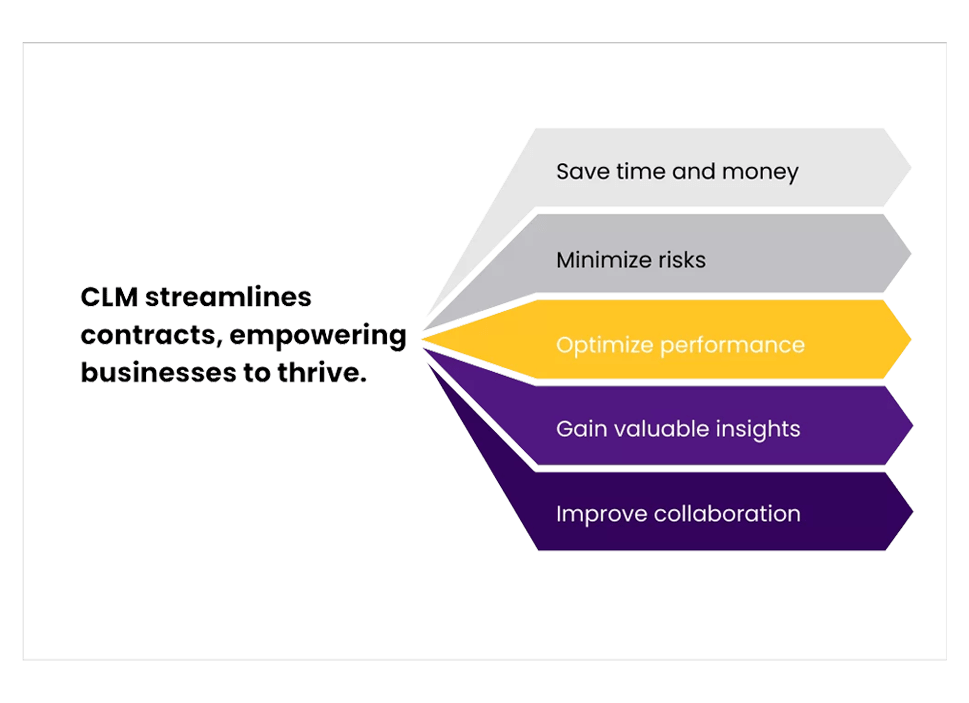
By streamlining the entire contract journey, CLM empowers businesses to:
- Save time and money: Automate routine tasks, eliminate errors, and reduce administrative burden.
- Minimize risks: Ensure compliance with regulations and avoid breach of contracts.
- Optimize performance: Track key milestones, monitor obligations, and identify areas for improvement.
- Gain valuable insights: Leverage data from contracts to make informed strategic decisions.
- Improve collaboration: Foster smooth communication and workflow between internal and external stakeholders.
A Brief History of CLM
Origins & Early Adoption:
- Pre-digital era (1990s and early 2000s): Contract management relied heavily on paper documents and manual processes, prone to errors and inefficiencies.
- Basic Document Management Systems (DMS) emerged, offering centralized storage and basic search functionalities, but still lacked significant automation or collaboration features.
Evolution with Market Needs:
- Mid-2000s to early 2000: Specialized CLM tools started appearing, focusing on specific stages like e-signatures or clause analysis. However, this fragmented approach often created data storage and hampered workflow continuity.
- The rise of AI and cloud computing paved the way for comprehensive CLM platforms that integrate automation, advanced analytics, and collaboration features.
Geographical Forces:
- Regional regulations and legal frameworks influence how CLM is adopted and implemented. For example, strict data privacy laws in Europe may necessitate specific security measures within CLM systems.
- Global markets with diverse business practices require CLM platforms to be flexible and adaptable to varying needs and workflows.
Today’s CLM Landscape:
- Modern CLM platforms are holistic solutions, offering end-to-end contract management encompassing creation, negotiation, approval, execution, and ongoing management.
- AI and machine learning are revolutionizing CLM by automating tasks, extracting insights from contracts, and predicting potential risks.
- The future of CLM lies in further integration with other business systems, advanced data analytics, and a growing focus on user experience and collaboration.
By understanding the evolution and importance of CLM, businesses, specially SMBs, can leverage its power to unlock unprecedented efficiency, agility, and success in today’s dynamic environment.
What is a Contract Lifecycle Management (CLM) System?
From creation to analysis, CLM is a finely tuned machine, each component playing a crucial role in optimizing your contract journey. Let’s delve into the heart of this powerhouse and explore its various functions:
#1. Contract Creation:

- Drafting Contracts: Skilled teams ensure airtight agreements, tailored to your specific needs and objectives.
- Templates and Standardization: Pre-built, customizable templates expedite routine contracts, ensuring consistency and accuracy.
- Collaboration in Creation: Real-time platforms foster seamless engagement between internal and external stakeholders, streamlining the drafting process.
#2. Contract Negotiation:
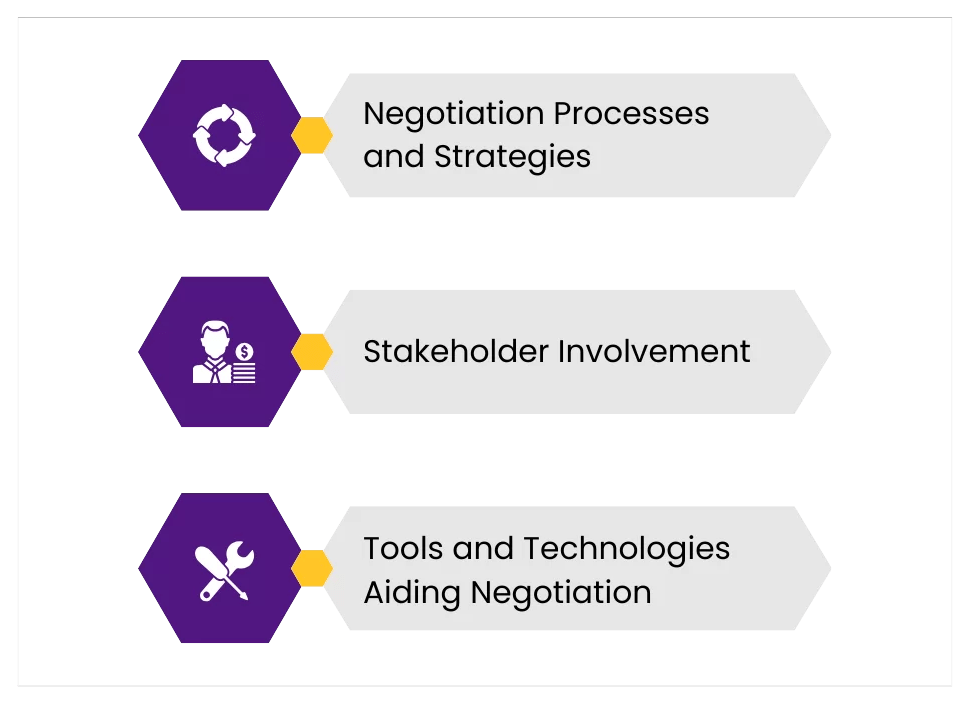
- Negotiation Processes and Strategies: Experts guide you through strategic planning, identifying critical clauses and formulating winning negotiation tactics.
- Stakeholder Involvement: Keep everyone informed and engaged, empowering a unified front during negotiations.
- Tools and Technologies Aiding Negotiation: Leverage AI-powered analysis to understand potential leverage points, identify weaknesses in the opposing party’s position, and optimize your own argument.
#3. Contract Approval:
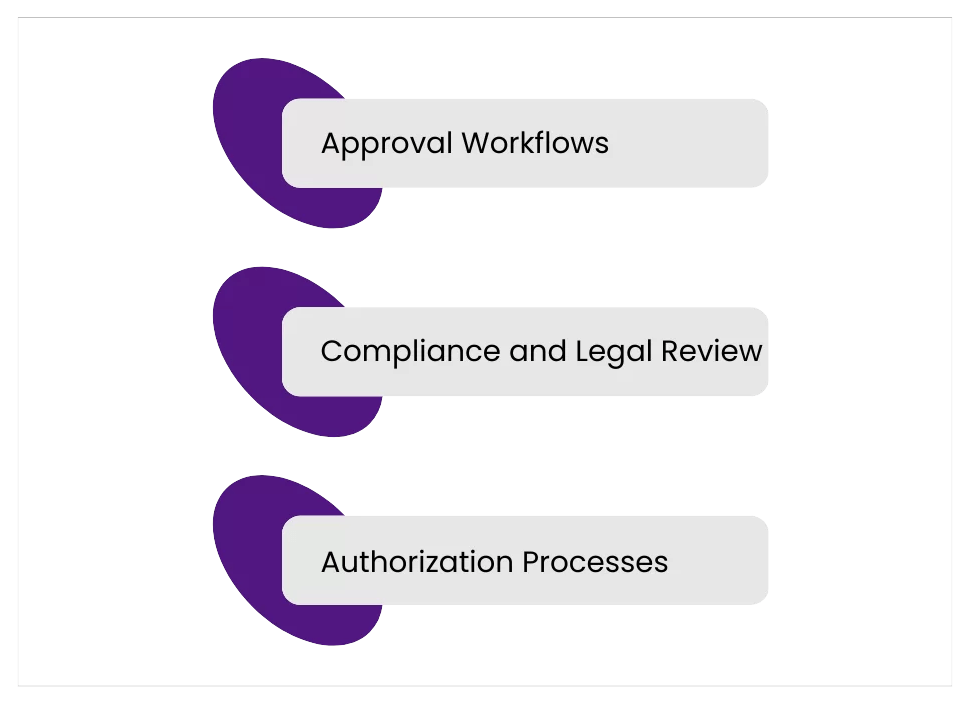
- Approval Workflows: Define clear, automated workflows for efficient approvals, reducing delays and bottlenecks.
- Compliance and Legal Review: Rigorous legal vetting minimizes risks and ensures adherence to regulations.
- Authorization Processes: Secure e-signatures and digital approvals expedite finalization, eliminating manual paperwork.
#4. Execution and Implementation:

- Signing and Execution Procedures: Implement streamlined e-signing procedures for smooth and swift contract execution.
- Ensuring Contract Adherence: Monitor performance, track key milestones, and address deviations promptly to ensure effective contract implementation.
- Transitioning from Negotiation to Implementation: Bridge the gap with expert guidance, avoiding delays and ensuring alignment between agreed terms and actual execution.
#5. Contract Management:
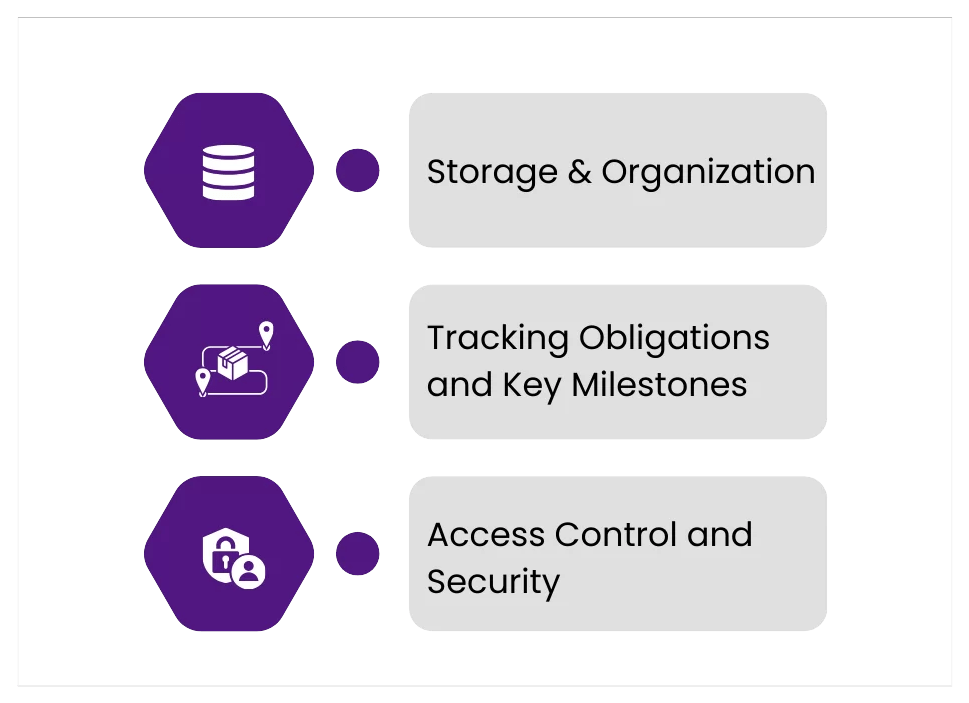
- Storage and Organization: Maintain a centralized, secure repository for easy access and retrieval of contracts.
- Tracking Obligations and Key Milestones: Automated notifications and reports keep you on top of deadlines and critical obligations.
- Access Control and Security: Granular access controls safeguard sensitive information and ensure data confidentiality.
#6. Contract Analysis and Optimization:

- Performance Tracking and Analysis: Uncover valuable insights from contracts using data analytics, identifying areas for improvement.
- Identifying Bottlenecks and Inefficiencies: Analyze historical data and current processes to pinpoint inefficiencies and optimize workflows.
- Strategies for Improving Contract Management Processes: Continuously assess and refine your CLM strategy, adapting to changes in your business needs and market conditions.
By understanding these key components and their interconnectivity, you can leverage CLM as a powerful tool to unlock operational efficiency, mitigate risks, and drive sustained success in today’s competitive business landscape.
Remember, CLM is not a static system, but a dynamic journey of continuous improvement. Embrace its power, analyze its performance, and optimize its processes to truly conquer the world of contracts.
Benefits & Importance of CLM
Contract Lifecycle Management (CLM) isn’t just software—it’s like a well-orchestrated performance that brings success to your business.
From the start of creating a contract to analyzing the results, CLM ensures a smooth flow of benefits, boosting operational efficiency, reducing risks, and leading to successful business outcomes.
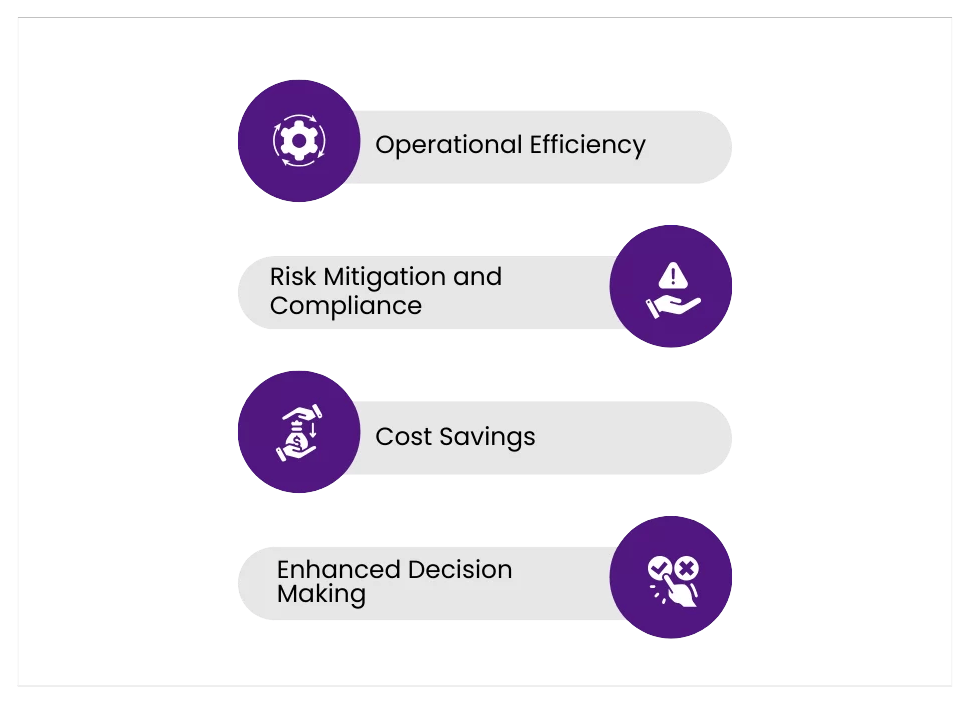
- Operational Efficiency: CLM makes contract processes feel like a well-rehearsed performance. It:
- Automates Routine Tasks: No more manual headaches. CLM handles tasks like creating templates, getting approvals, and using e-signatures, making everything consistent and error-free.
- Reduces Errors: CLM takes care of data entry and verifies clauses automatically, avoiding mistakes and saving you money by preventing rework.
- Risk Mitigation and Compliance: Contracts can be tricky, but CLM acts as a guardian, identifying risks and ensuring compliance:
- Identifies and Mitigates Risks: CLM spots potential issues and helps you fix them before they cause trouble. It uses AI to analyze clauses and check compliance, so you’re always prepared.
- Ensures Regulatory Compliance: Navigating regulations becomes easier with CLM, ensuring your contracts align with the law and avoiding penalties.
- Cost Savings: CLM brings financial harmony by:
- Reducing Operational Costs: Automation leads to significant savings, from e-signatures reducing postage fees to faster approvals minimizing delays.
- Avoiding Penalties and Fines: CLM’s checks and balances keep you away from costly mistakes, ensuring your financial performance stays on track.
- Enhanced Decision Making: Contracts hold valuable data, and CLM helps you use it for better decisions:
- Data-Driven Insights: CLM digs into your contracts, finding trends and insights you might have missed, helping you make informed decisions.
- Influence on Strategic Decisions: Use CLM’s insights to negotiate better terms, optimize performance, and align actions with long-term goals.
Embrace CLM’s power to lead your business to growth and prosperity. It’s not a one-time fix; it’s a journey of continuous improvement. Keep analyzing, refining, and unlocking its full potential to conquer the world of contracts!
Implementation, Contract Security, & Best Practices
CLM Implementation Strategies
Successfully implementing Contract Lifecycle Management (CLM) requires careful planning and execution. Here’s a detailed guide:
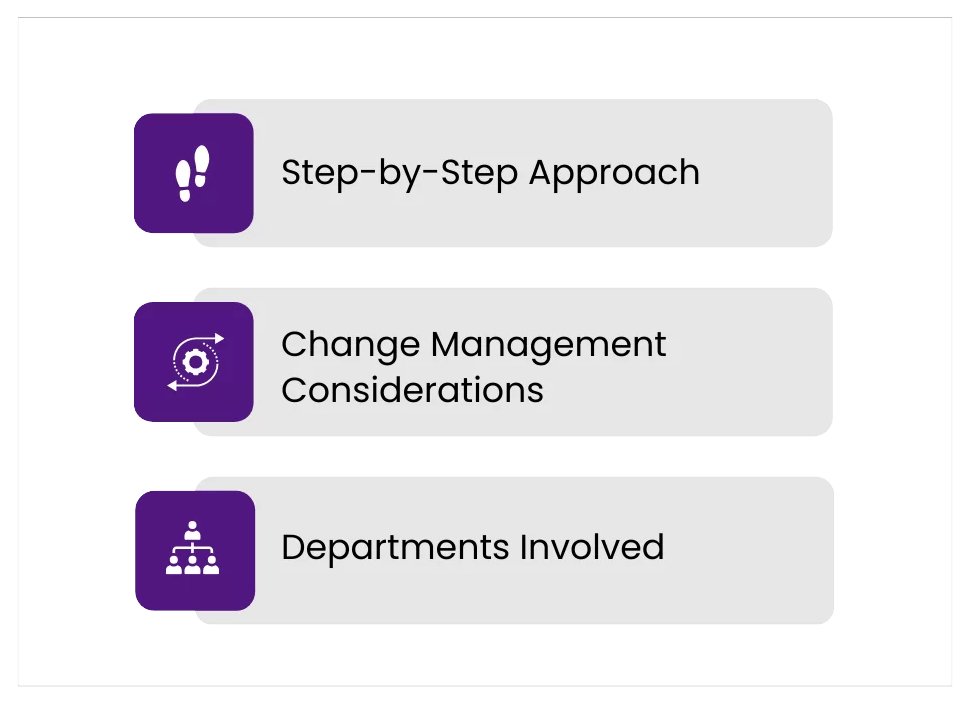
- Step-by-Step Approach: Begin with a phased approach. Start by implementing CLM for straightforward contracts before moving on to more complex ones. This gradual rollout allows users to familiarize themselves with the system progressively.
- Change Management Considerations: Recognize that change can be met with resistance. Clearly communicate the benefits of CLM to all stakeholders and provide comprehensive training programs. Involving employees in the process, addressing concerns, and highlighting the positive impact of CLM on their work can help overcome resistance.
- Departments Involved: Foster collaboration among various departments. Legal, procurement, and other relevant departments should actively participate in the implementation process to ensure that CLM aligns with their specific needs and workflows.
Contract Security
Ensuring the security of contracts is paramount. Here’s a more in-depth look:
- Why Security Matters: Contracts often contain sensitive information such as financial details and legal terms. Protecting this data is essential to prevent unauthorized access, fraud, or leaks. Robust security measures safeguard the confidentiality and integrity of contracts.
- Various Security Options: Implement multiple layers of security. Two-way authentication adds an additional verification step for access, enhancing the overall security posture. Encryption, utilizing algorithms to scramble information, adds an extra layer of protection, making it unreadable to unauthorized individuals.
Adoption Challenges and Solutions
Overcoming challenges during CLM adoption is crucial for its success. Dive deeper into the process:
- Common Challenges: Resistance to change and technical issues are common hurdles. Identifying these challenges early on allows for proactive problem-solving.
- Strategies to Overcome Resistance: Develop a comprehensive communication plan that highlights the advantages of CLM. Conduct training programs to ensure users are well-equipped to navigate the new system. Encourage an open feedback loop to address concerns and continuously refine the CLM implementation.
Best Practices in Contract Lifecycle Management (CLM)
Optimizing CLM involves adopting best practices. Here’s a more detailed exploration:
- Establish Standardized Processes: Define and document standardized processes for contract creation, negotiation, and approval. This consistency reduces errors, enhances efficiency, and ensures that all stakeholders follow a unified approach.
- Continuous Improvement Methodologies: Implement methodologies for ongoing refinement. Regularly review CLM processes, gather feedback from users, and make necessary adjustments. This iterative approach ensures that CLM remains effective and aligns with evolving business needs.
Implementing CLM, ensuring contract security, and following contract management best practices demand meticulous attention to detail. By breaking down each aspect and addressing specific considerations, organizations can navigate the complexities of CLM adoption with confidence.
Success Stories
Learn how companies from diverse industries including technology, marketing and film have benefited from Vyapi CLM and how it helped their fast-growing contract needs.
Emerging Trends in CLM
#1. AI and Automation in CLM
The future of Contract Lifecycle Management (CLM) is intricately tied to advancements in artificial intelligence (AI) and automation. These technologies are revolutionizing how contracts are managed, offering efficiency and accuracy.
AI can analyze vast amounts of data, providing insights into contract performance, identifying potential risks, and suggesting optimization strategies. Automation streamlines routine tasks, from contract creation to approval workflows, freeing up valuable time for more strategic activities.
The integration of AI and automation not only enhances operational efficiency but also reduces the likelihood of human errors, ensuring precision in contract management processes.
[Related Read: The Future of Generative AI in the Legal Industry]
#2. Blockchain in Contract Management
Blockchain technology is making waves in the world of contract management. Its decentralized and tamper-resistant nature offers enhanced security and transparency.
In contract management, blockchain ensures that once a contract is recorded, it cannot be altered without consensus from all parties involved. This not only mitigates the risk of fraud but also brings a new level of trust to contractual relationships.
Smart contracts, powered by blockchain, have the potential to automate and enforce contract terms without the need for intermediaries. This not only speeds up processes but also reduces costs and minimizes the risk of disputes.
Conclusion
Recap of Key Points
In this exploration of Contract Lifecycle Management, we’ve delved into its transformative impact on business operations.
From operational efficiency to risk mitigation to debunking contract management myths, CLM has proven to be a critical asset in ensuring the smooth orchestration of contract-related processes.
We highlighted the significance of a step-by-step approach in implementation, emphasizing change management considerations and the collaboration of various departments.
Outlook for CLM
Looking ahead, the future of CLM appears promising, driven by emerging trends.
The integration of AI and automation is set to revolutionize how contracts are managed, introducing unprecedented levels of efficiency and accuracy.
Blockchain technology, with its emphasis on security and transparency, is reshaping the landscape of contract management, promising a future where trust is embedded in every contractual relationship.
As organizations embrace these advancements, the future of CLM is likely to witness a shift towards more streamlined, secure, and intelligent contract management processes. The continuous evolution of technology and its integration into CLM signifies a dynamic journey of improvement and adaptation.
In conclusion, CLM is not just a static solution but a dynamic force that aligns with the evolving needs of businesses.
By leveraging emerging technologies and staying attuned to future contract management trends, organizations can conduct their business symphony with confidence, efficiency, and resilience in the ever-changing landscape of contracts.
